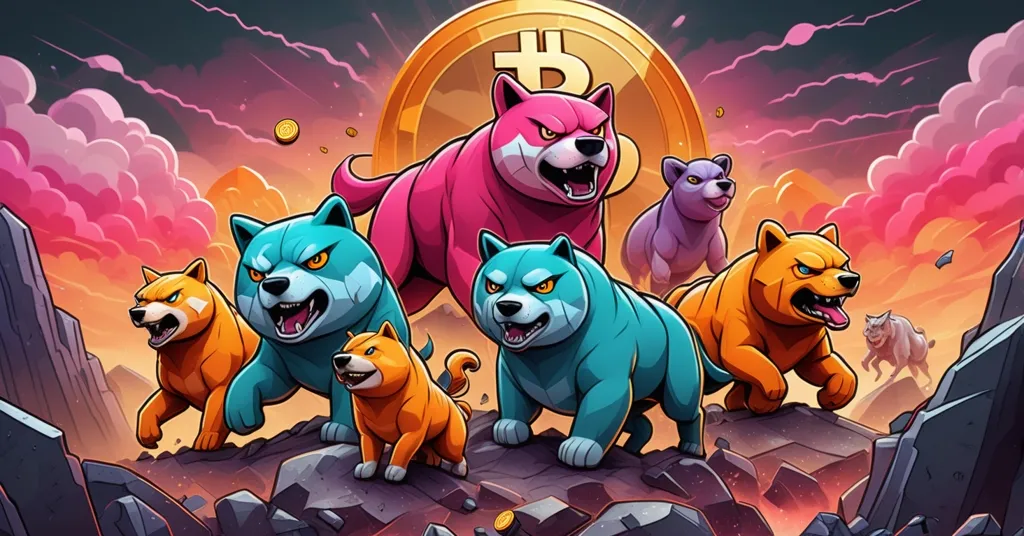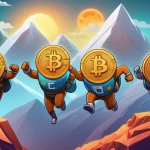Top 5 Cryptos Defying 2023 Market Fears: Little Pepe, Toncoin, and More

Top 5 Cryptocurrencies Beating Market Fears in 2023: Little Pepe, Toncoin & More
Amidst a cryptocurrency market battered by relentless volatility and investor jitters, a few underdog projects are clawing their way into the limelight. With Bitcoin stumbling and regulatory storm clouds looming, can a meme token or a mobile mining app truly outshine the king of crypto? Let’s unpack five cryptocurrencies—Little Pepe (LILPEPE), Notcoin, Toncoin, PI, and Hamster Kombat—that are defying market fears with innovation, community grit, and a sprinkle of speculative mania.
- Little Pepe (LILPEPE): A meme token on a Layer 2 blockchain, raising nearly $27 million in presale with ultra-low fees and speedy transactions.
- Notcoin: A DeFi player focusing on stability and cross-chain interoperability despite market chaos.
- Toncoin: A scalable Layer 1 blockchain with Ethereum compatibility, luring developers with efficiency.
- PI: A mobile-first crypto pushing smartphone mining to democratize access.
- Hamster Kombat: A gamified DeFi token mixing entertainment with blockchain rewards for community buzz.
Market Context: Fear Rules, Yet Some Thrive
The crypto market in 2023 is a pressure cooker. Bitcoin, the bedrock of decentralization, has seen price dips below key psychological levels, with some weeks showing losses of over 10%. Regulatory noise—think SEC crackdowns in the US and murky policies in the EU—has spooked investors, while macroeconomic headwinds like rising interest rates siphon capital to safer havens. Yet, in this lawless frontier of code and capital, certain projects are shrugging off the gloom. Community-driven momentum, technical innovation, and niche applications are separating the wheat from the chaff. These five cryptocurrencies aren’t just surviving; they’re grabbing headlines by addressing real pain points or, frankly, riding waves of hype, as highlighted in discussions about cryptos stealing the spotlight despite market fears. Let’s dig into each, balancing the promise against the peril, because in crypto, today’s hero is often tomorrow’s zero.
Little Pepe (LILPEPE): Meme Token with $27M Presale Power
First on the list is Little Pepe (LILPEPE), a meme token that’s turned heads with a jaw-dropping presale haul of nearly $27 million. Currently in Stage 13 of its presale, with 96.44% of tokens sold and the next stage price set at $0.0023, this project isn’t just coasting on cute branding. Built on a Layer 2 blockchain—a secondary network that processes transactions faster and cheaper than the main chain, like Ethereum—Little Pepe offers ultra-low fees and rapid finality. It’s also compatible with the Ethereum Virtual Machine (EVM), a software environment allowing developers to build apps using familiar Ethereum coding tools. Throw in plans for a meme-focused launchpad with anti-sniper bot tech to prevent unfair token grabs during launches, and you’ve got a project aiming for both fun and fairness.
But let’s not sip the Kool-Aid just yet. Presales are sexy, but they’re also a notorious gamble. For every success, there’s a rug pull horror story—think Squid Game token in 2021, where devs vanished with millions overnight. Little Pepe’s $27 million raise begs questions: who’s buying? Are whales hoarding tokens for a post-launch dump? Without transparent audits or distribution data (check their site or Telegram for updates), it’s a lottery ticket at best. Their Mega Giveaway, offering over 15 ETH in prizes including a 5 ETH top bounty for big buyers in stages 12-17, smells like a marketing ploy to lure more FOMO-driven cash. Meme tokens can moon—Dogecoin’s 2021 run proves that—but most crash harder than a house of cards. If you’re eyeing Little Pepe, tread lightly and bet only what you can afford to lose.
Notcoin: Stability in a Sea of Chaos
Next up, Notcoin is making waves in decentralized finance (DeFi), a catch-all for blockchain-based financial tools that ditch middlemen like banks. Unlike the meme-driven frenzy of Little Pepe, Notcoin prioritizes stability and interoperability via cross-chain bridges—tech that lets assets hop between blockchains, say from Ethereum to Binance Smart Chain, without a hitch. In a market where double-digit price swings are the norm, Notcoin’s steady performance and loyal community stand out. It’s pitched as a safe harbor for DeFi users who want practical applications, not just speculative fireworks.
Here’s the flip side: stability in crypto can be a mirage or, worse, a sign of stagnation. If Notcoin isn’t seeing wild price action, is that because it’s rock-solid or just ignored? DeFi is a crowded space—think Uniswap, Aave—and cross-chain bridges have been hacker magnets, with exploits like the $600 million Poly Network hack in 2021 as a grim reminder. Notcoin’s community strength is a plus, but without specifics on user numbers or locked value (check CoinMarketCap for real-time data), it’s hard to gauge if this is a sleeper hit or a slow fade. For DeFi buffs, it’s worth a peek, but don’t expect miracles in a bearish storm.
Toncoin: Scalability with Ethereum Flair
Toncoin enters the fray as a Layer 1 blockchain—meaning it’s a base protocol like Bitcoin or Ethereum, not a sidecar like Layer 2. Its pitch? Scalability. With claims of handling thousands of transactions per second (TPS), Toncoin dwarfs Ethereum’s sluggish 15-30 TPS, though it lags behind Solana’s hyped 65,000 TPS under ideal conditions. Its compatibility with Ethereum-based apps via EVM support means developers can port over projects without learning a new playbook, a huge draw for efficiency seekers. Adoption is reportedly ticking up, which could spark speculative interest as more dApps (decentralized apps) take root.
But scalability promises are crypto’s oldest broken record. Everyone claims to be the “Ethereum killer”—remember EOS or Cardano’s bold talk? Toncoin’s high TPS sounds great, but real-world stress tests are scarce. Ethereum compatibility is a double-edged sword; it might dilute the raw decentralization Bitcoin maximalists like myself cherish, trading security for speed. Compared to Polygon, a Layer 2 rival, or Solana, Toncoin’s dev activity on GitHub needs scrutiny to back the hype. It fills a niche Bitcoin doesn’t—massive throughput for dApps—but at what cost to resilience? Developers might love it, but end users won’t care if it can’t survive a hack or a downturn.
PI: Mobile Mining for the Masses
PI takes a different tack, betting that crypto’s future isn’t on desktops but in pockets. This mobile-first project lets users mine and transact via smartphones, slashing barriers for non-techies who lack powerful hardware. Imagine earning small rewards by running an app, akin to collecting points in a mobile game, but with potential real-world value. With mobile finance exploding—think M-Pesa in Africa, handling billions in transactions—PI’s vision of onboarding millions in underbanked regions could be a game-changer for financial inclusion.
Now, the cold water: mobile mining often screams red flags. Energy drain, security holes, and outright scams have plagued similar projects—remember Phoneum or Electroneum’s lukewarm reception? PI’s accessibility push is noble, but can it secure transactions on devices prone to loss or hacking? Integration into payment systems sounds futuristic, but without hard partnerships or adoption stats, it’s more wish than reality. Bitcoin’s clunky design never aimed for phone-first ease, and maybe that’s wise—security over convenience. PI could crack open a new user base, or it might just overheat your phone for pennies. Dig into their tech before jumping in.
Hamster Kombat: DeFi Meets Digital Carnival
Lastly, Hamster Kombat brings a smirk to the table with gamified DeFi mechanics—think earning tokens through game-like tasks rather than pure staking or trading. It’s less about revolutionizing finance and more about entertainment, building a rabid community with early trading buzz. Meme tokens like Dogecoin, which spiked to a $90 billion market cap in 2021 on Elon Musk tweets alone, prove that humor plus hype equals cash. Hamster Kombat’s blend of fun and blockchain rewards taps that same speculative vein, positioning it as the slot machine of crypto—cute mascot included.
Let’s be real: this is a carnival game, not a retirement plan. Meme tokens are digital casino chips, often collapsing when the laughter fades—Shiba Inu’s 80% drop post-peak is a sobering lesson. Community engagement is great, but without utility beyond “lol, hamsters,” sustainability is a pipe dream. Bitcoin’s value lies in scarcity and security; Hamster Kombat’s is pure zeitgeist. Early traders might flip a profit, but latecomers usually hold the bag. If you play, treat it as a gag, not a gospel.
What Ties Them Together—and What Could Break Them
These five cryptocurrencies—Little Pepe, Notcoin, Toncoin, PI, and Hamster Kombat—share a knack for capturing attention amidst market dread. Community grit, whether through presales, social buzz, or gamified hooks, is their lifeblood. Utility, or at least the promise of it, also binds them: speed for Little Pepe, stability for Notcoin, scalability for Toncoin, access for PI, and cultural appeal for Hamster Kombat. Each tackles a slice of blockchain’s evolution, filling gaps Bitcoin, by design, often ignores.
Yet, the fault lines are glaring. Presale scams, untested tech, and speculative froth threaten to unravel them. Little Pepe and Hamster Kombat could vanish like countless meme flops. Notcoin’s calm might mask irrelevance. Toncoin’s scalability and PI’s mobile dreams face execution risks—hackers and inefficiency don’t care about vision. Crypto remains a high-stakes poker game; these projects might be holding aces or just bluffing. Due diligence isn’t optional—it’s survival.
Bitcoin Maximalist Lens: Why Altcoins Still Matter
As a Bitcoin maximalist, I’ll always argue that BTC’s unyielding focus on security and decentralization trumps all. It’s the gold standard, the ultimate middle finger to centralized control. But I can’t ignore that altcoins like these five push boundaries Bitcoin doesn’t. Toncoin’s speed, PI’s accessibility, even Hamster Kombat’s absurdity—these experiments drive adoption and test what decentralized tech can do. Bitcoin can’t be everything to everyone; it shouldn’t be. These projects, flawed as they are, fuel the broader fight for financial freedom and innovation. They’re not replacements, but they’re useful provocations, reminding us why we’re here: to disrupt, to decentralize, to accelerate change.
Key Questions and Takeaways
- What makes these cryptocurrencies stand out in a volatile 2023 market?
Their resilience stems from strong communities, innovative angles like Layer 2 speed or mobile mining, and strategic moves like presales that build early trust and liquidity. - Is Little Pepe (LILPEPE) a safe bet with its $27 million presale?
Hell no. No crypto is “safe,” and presales are a minefield. That $27 million is impressive, but without audits or transparency on token distribution, it’s a high-risk play. - How does Toncoin’s Ethereum compatibility boost the crypto space?
It lets developers build scalable apps with familiar Ethereum tools on a faster network, potentially speeding up decentralized app adoption—though at a possible cost to pure decentralization. - Can PI truly democratize crypto through mobile access?
It has potential to onboard millions via smartphones, especially in underbanked regions, but security flaws and energy concerns with mobile mining could derail its mission. - Are meme tokens like Hamster Kombat worth the hype?
They can explode with community fervor and entertainment value, but their speculative nature means most fizzle out. Treat them as a gamble, not a goldmine.
Navigating today’s crypto market demands a sharp mind and a thicker skin. Little Pepe, Notcoin, Toncoin, PI, and Hamster Kombat offer glimmers of hope—or at least distraction—during brutal times. They showcase blockchain’s wild diversity, from lightning-fast transactions to smartphone mining to digital carnivals. But in this raw, untamed space, promises are cheap, and failures are costly. Stay skeptical, dig into the code or at least the community, and never wager more than you’re ready to watch burn. The fight for decentralization marches on, and these projects, for better or worse, are part of the battlefield.



